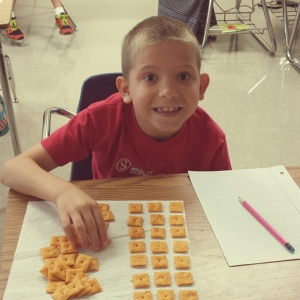Lesson Topic:
“Hip, Hip ARRAY”—the purpose of this lesson was to introduce/review multiplication via array models. An array is a rectangular arrangement of equal groups of objects in rows and columns. Array models are introduced to students as early as second grade.
Goal for Students On-Level: Given both an explanation and a visual representation of the array strategy, guided practice with manipulatives, and an array handout, STUDENTS will independently complete the array handout, with at least 80% accuracy, within a 50-minute math lesson.
Goal for Students Needing Small-Group Instruction: Given both an explanation and a visual representation of the array strategy, guided practice with manipulatives, and an array handout, STUDENTS will independently complete the array handout, with at least 80% accuracy, with assistance from the paraprofessional, within a 50-minute math lesson.
Date Taught:
Tuesday, July 21, 2015
What went well?
I think that this lesson’s combination of manipulatives (Cheez-Its) and anchor charts certainly helped my students better connect multiplication to that of repeated addition. The guided practice really allowed me to observe how students were thinking. During guided practice, I assigned a series of multiplication problems on the board (i.e. 3×5=). Students then responded to each problem using Cheez-Its—the “objects” in their array models. After illustrating with array models, we then solved for each product. I liked this initial activity because it required students to actually construct the arrays instead of simply identifying previously arranged arrays. I think that my students were challenged with a more rigorous, tactile task. Not to mention, yumminess overload!
What did not go as planned?
Today’s math lesson took much longer than I had planned. In fact, we didn’t have time to even begin the independent practice handout. Consequently, no one met my original goals. I’ve already noted a couple of factors that perhaps contributed to today’s pacing. At the start of the lesson, I immediately detected that my students didn’t “remember” very much about the term multiplication—I felt as if I had three heads or something. And because multiplication seemed so unfamiliar to them, I don’t think that a review lesson, using arrays, was the best approach. Arrays can be complex at first, considering that students must be able to distinguish “rows” from “columns.” Therefore, I should have expected for my guided practice to require more time.
How to change for subsequent lessons:
Knowing what I know now, I think it best to begin any sort of multiplication lesson, whether an introduction or a review, using illustrations involving “equal groups of.” I think students need to see the pictorial representations of multiplication using groups. Keeping my previous example, 3×5 would look like three circles with five objects inside each circle. Multiple examples of this strategy should be provided. Once students have mastered the basics, I think it’s then appropriate to introduce array models as another multiplication strategy. I was proud of my students’ success—they worked very hard. I simply think that this lesson would have been more beneficial had it come later in the unit.


Teresa, my small group and I learned plenty today during your multiplication lesson. I like how you reinforced rows and columns that really helped the students understand how to multiply using “how many across” times “how many going up and down”.
Using the edible manipulative had the students eager to move forward in the learning!
LikeLike
I thought it was a great lesson! Any time food is used as a manipulative, it usually grabs the student’s attention. I also thought you did a great job modeling how to make an array and gave lots of examples. You didn’t rush through the lesson and really took the time to make sure they grasped the concept before moving on to the next activity.
LikeLike
Teresa, I love this lesson! I teach it with my students at school and I think it is one of their favorites. Just like you, I learned that it was important to teach students the difference between rows and columns. This is a piece of knowledge we assume they know- but some don’t! I love your title and the pictures are adorable. I think the combo of anchor charts and manipulatives really worked in reinforcing the concept. Keep doing a wonderful job!
LikeLike
Teresa,
I really enjoyed reading how you used food as a manipulative for multiplication. That was such a great idea since it probably motivated students to complete their work. I am sorry that you didn’t get through everything you wanted in your lesson, but it seems like you adjusted well to how your students reacted.
LikeLike
Teresa,
I love that you used cheez-its to teach this lesson. I bet the students loved it!! I always find they get more out of math lessons when they have a visual. We did a similar lesson in which our students had draw arrays. I really like that you made your lesson hands-on. Let me know how your follow up lessons go. I could definitely use this in my classroom!!
LikeLike